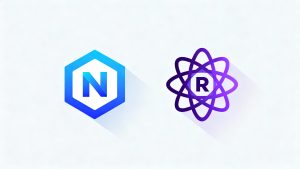The MERN stack—MongoDB, Express.js, React.js, and Node.js—has emerged as one of the most popular technology stacks for building full-stack JavaScript applications. Its appeal lies in the unified use of JavaScript across the frontend and backend, creating a seamless development experience.
Whether you’re a fresh developer trying to land your first job or a seasoned programmer looking to switch roles, preparing for MERN stack interviews is crucial. In this blog, we’ll break down the 10 most commonly asked MERN stack developer interview questions, including code snippets and detailed answers to help you gain confidence and ace your next interview.
1. What is the MERN Stack? How does each component work together?
Answer:
The MERN stack is a JavaScript-based full-stack framework composed of:
- MongoDB – NoSQL database that stores application data as documents.
- Express.js – Backend web application framework for Node.js.
- React.js – JavaScript library for building user interfaces.
- Node.js – JavaScript runtime environment for executing code outside the browser.
Together, they allow end-to-end development in JavaScript.
javascript
// Sample flow:
// React frontend calls an API
fetch('/api/users')
.then(res => res.json())
.then(data => console.log(data));
// Express backend handles the route
app.get('/api/users', async (req, res) => {
const users = await User.find(); // MongoDB query
res.json(users);
});2. How is data passed from the frontend (React) to the backend (Express)?
Answer:
Data is sent from the frontend using HTTP methods like POST, GET, PUT, DELETE through APIs. Here’s a simple example of a POST request:
Frontend (React):
javascript
const handleSubmit = async () => {
await fetch('/api/create-user', {
method: 'POST',
headers: { 'Content-Type': 'application/json' },
body: JSON.stringify({ name: 'John Doe' })
});
};Backend (Express):
javascript
app.post('/api/create-user', async (req, res) => {
const { name } = req.body;
const newUser = new User({ name });
await newUser.save();
res.status(201).send('User created');
});3. What is a virtual DOM, and how does React use it?
Answer:
The Virtual DOM is a lightweight copy of the actual DOM in memory. React uses it to detect changes efficiently.
When state changes in a component, React creates a new virtual DOM tree and compares it with the previous one (diffing). Then, it updates only the changed parts in the actual DOM (reconciliation), resulting in faster performance.
javascript
const [count, setCount] = useState(0);
<button onClick={() => setCount(count + 1)}>Click Me</button>On button click, React updates the virtual DOM, calculates the difference, and updates the browser’s DOM accordingly.
4. Explain the role of MongoDB in the MERN stack. How is it different from SQL?
Answer:
MongoDB is a document-oriented NoSQL database. Unlike SQL databases which use rows and tables, MongoDB uses collections and JSON-like documents.
SQL:
sql
CopyEdit
SELECT * FROM users WHERE age > 25;MongoDB:
javascript
db.users.find({ age: { $gt: 25 } });MongoDB offers flexibility, scalability, and is ideal for handling unstructured data—making it perfect for modern web apps.
5. How do you manage state in a React application?
Answer:
React offers several ways to manage state:
- Local State: Using useState and useReducer.
- Global State: Context API or third-party libraries like Redux or Zustand.
- Server State: React Query, SWR.
- URL State: Query parameters, navigation state.
javascript
const [input, setInput] = useState('');
<input value={input} onChange={(e) => setInput(e.target.value)} />For larger applications, Redux helps manage complex state structures.
6. What is middleware in Express.js?
Answer:
Middleware functions are functions that have access to the req, res, and next() objects. They are used to modify request and response objects or to execute specific logic.
javascript
const logger = (req, res, next) => {
console.log(`${req.method} ${req.url}`);
next(); // Pass control to next middleware
};
app.use(logger);They’re useful for authentication, logging, error handling, etc.
7. How does React handle component lifecycle?
Answer:
React functional components manage lifecycle through hooks:
- useEffect: Acts like componentDidMount, componentDidUpdate, and componentWillUnmount.
javascript
useEffect(() => {
console.log('Component mounted');
return () => console.log('Component unmounted');
}, []);You can also track changes using dependencies in the second argument.
8. Explain how authentication works in a MERN stack app.
Answer:
Typical authentication involves:
- User submits a login form.
- Backend verifies credentials.
- Backend sends a JWT (JSON Web Token) on success.
- Client stores the token (e.g., in localStorage).
- Token is sent in Authorization headers on protected routes.
Login API:
javascript
app.post('/api/login', (req, res) => {
const token = jwt.sign({ userId }, 'secretKey', { expiresIn: '1h' });
res.json({ token });
});Middleware to protect routes:
javascript
const verifyToken = (req, res, next) => {
const token = req.headers['authorization'];
if (!token) return res.sendStatus(403);
jwt.verify(token, 'secretKey', (err, decoded) => {
if (err) return res.sendStatus(403);
req.user = decoded;
next();
});
};9. How do you deploy a MERN stack app?
Answer:
Deployment involves both frontend and backend:
- Frontend (React):
- Build the app: npm run build
- Serve using Nginx, Netlify, or Vercel.
- Backend (Express):
- Host on services like Heroku, Render, or AWS.
- Use reverse proxy to serve frontend from Express.
Serving React from Express:
javascript
app.use(express.static('client/build'));
app.get('*', (req, res) => {
res.sendFile(path.resolve(__dirname, 'client', 'build', 'index.html'));
});10. What are some best practices when building a MERN stack app?
Answer:
- Folder Structure: Keep separate folders for frontend and backend.
- Environment Variables: Use .env for sensitive configs.
- Code Quality: Linting (ESLint), formatting (Prettier).
- Security: Use Helmet, CORS, input validation, and hashed passwords.
- Testing: Use Jest for React and Mocha/Chai for Node.js.
javascript
// Example: password hashing
const bcrypt = require('bcrypt');
const hashed = await bcrypt.hash(password, 10);Conclusion
Mastering the MERN stack—MongoDB, Express.js, React.js, and Node.js—is more than just learning a set of tools. It’s about understanding how to architect robust, scalable, and high-performance web applications using JavaScript end-to-end. As modern web development continues to lean into JavaScript-centric stacks, MERN developers are in high demand across startups, tech giants, and enterprise teams alike.
Interviewers today are not just evaluating your syntax knowledge—they’re assessing your ability to solve problems, structure clean code, manage state effectively, connect databases seamlessly, and deploy full-stack applications with confidence. They want to know if you can integrate APIs, optimize performance, debug efficiently, and make smart design decisions.
The best way to prepare is to go beyond theoretical answers:
- Build real-world projects like blogs, e-commerce apps, or dashboards.
- Contribute to open-source repositories to learn how collaborative development works.
- Explore deeper topics like authentication flows, performance optimization, caching, security best practices, and CI/CD pipelines.
- Stay updated on evolving React features (like concurrent mode), Node.js updates, and MongoDB integrations.
By practicing these commonly asked interview questions—with hands-on code examples—you’ll be equipped not only to pass interviews but to stand out as a confident, capable full-stack JavaScript developer.
So keep building, keep experimenting, and approach interviews as a showcase of your journey through the modern web development landscape. The MERN stack isn’t just a toolset—it’s a gateway to countless opportunities in the ever-evolving world of tech.



